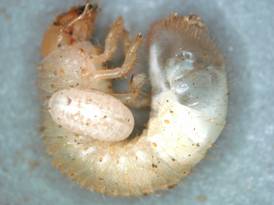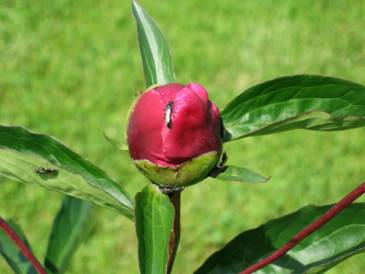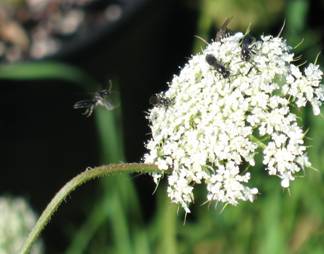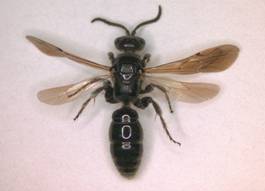Have you wondered what natural enemies are out there that kill Japanese or oriental beetle grubs? Have you wondered if there is anything you can do to help or conserve these natural enemies? Well, there is. There are two species of parasitoid or parasitic wasps found in Connecticut and other Northeastern states which contribute to the mortality of Japanese and of oriental beetle grubs. The first species is the spring Tiphia or Tiphia vernalis. These wasps are active from May to early June and they attack the 3rd instars grubs (overwintered, oldest grubs). The second species is the summer Tiphia or Tiphia popilliavora. The summer Tiphia attack 2nd or 3rd instar grubs from August to early September. The wasps are solitary therefore they do not form nests and do not disturb the turfgrass in any way. Both species attack grubs by digging into the soil in search of grubs. When a grub is found, the wasp stings it and paralyzes it momentarily while the wasp attaches one egg on the ventral side of the grub. When the wasp egg hatches, the resulting parasitic larva begins feeding on the grub. The parasitic larva is found outside the host, securely attached and it will feed on the grub until the host grub dies (Fig.1). Tiphia females live for about a month and may lay 40-50 eggs on as many different grubs.
Many parasitoid wasp species visit flowers to obtain nectar and/or pollen that provide essential nutrients. This in turn has been shown for many parasitoid species to improve fecundity, longevity and increase rates of parasitism. Thus, one approach to help or conserve these Tiphia wasps is to provide food resources either through food sprays or by including flowering plants that can provide food resources over a period of time. The Tiphia species described here use nectar or sugary substances to supplement their diet. Spring Tiphia adults emerge in the spring and they have been observed feeding on honeydew deposits from soft scales or aphids and on nectar. Summer Tiphia is said to feed on nectar from wild carrot Daucus carota.

Fig. 1. Spring Tiphia larva feeding on Japanese beetle grub.

Fig. 2 Spring Tiphia adults feeding on peony ‘Big Ben’ extrafloral nectar.
Studies done at the University of Connecticut indicated which ornamental plants to use as nectar sources for these wasps. For the spring Tiphia the best choice is peonies (Paeonia lactiflora). For example, the peony cultivars ‘Big Ben’, ‘Bowl of Beauty’, ‘Festiva Maxima’ and ‘Sarah Bernhardt’ were all shown to attract spring Tiphia wasps. Peonies secrete extrafloral nectar through the calyx of unopened flower buds. You will see wasps on the flower buds consuming nectar (Fig. 2) until the flower opens and then the nectar flow ceases. Other ornamental plants were tested but they did not fare as well as peonies in terms of attracting Tiphia wasps and also not serving as a food item for Japanese beetles. Peonies did not sustain any damage from adult Japanese beetles either in the open field or in caged experiments. Table 1 gives more information about the peonies recommended above.
Table 1. Examples of peony cultivars that can be used to attract spring Tiphia wasps.
| Peony Cultivar | Flower | Bloom Time | Mature Size | Planting site |
| Big Ben | Deep red | Early May | 36-42” t 24×36”w | Full sun, well-drained soil |
| Festiva Maxima | White double flowers | May – June | 18-24” t 18-24”w | Full sun or part shade in well drained, loamy soil |
| Bowl of Beauty | Double cream and pink with a yellow center | May – June | 24-30” t 24-30” w | Full sun |
| Sarah Bernhardt | Double rose-pink flowers | Late May | 30-36”t 18-24”w | Full sun or partial shade, well drained soil |
Several ornamental and herb plants were tested as potential nectar sources for the summer Tiphia. However, only wild carrot plants were attractive to this wasp out of all other plants tested such as yarrow, ornamental goldenrod, dill, fennel, and cilantro. At this moment, only wild carrot can be recommended for attracting summer Tiphia (Figs. 3 & 4). Wild carrot is considered a weed but it is an aesthetically pleasing plant (its popular name is Queen Anne’s lace) that some homeowners or other private entities might find useful. This biennial plant is native to Europe and southwest Asia and can grow 2- 4 ft. tall.

Fig. 3 Summer Tiphia adults feeding on wild carrot nectar.

Fig. 4 Summer Tiphia adult.
References
Legrand, 2009a. Evaluation of ornamental plants as nectar sources for summer Tiphia. p. 77-79. In K. Guillard (ed), 2009 Annual Turfgrass Research Report, College of Agriculture and Natural Resources, University of Connecticut.
Legrand, 2009b. Evaluation of landscape ornamental plants as nectar plants for Tiphia vernalis and as host plants for pest scarab beetles. p. 73-76. In K. Guillard (ed), 2009 Annual Turfgrass Research Report, College of Agriculture and Natural Resources, University of Connecticut.
Prepared by Ana Legrand, UConn Extension IPM Team
Publication supported by UConn IPM Program and the Northeastern IPM Center
The information in this document is for educational purposes only. The recommendations contained are based on the best available knowledge at the time of publication. Any reference to commercial products, trade or brand names is for information only, and no endorsement or approval is intended. The Cooperative Extension System does not guarantee or warrant the standard of any product referenced or imply approval of the product to the exclusion of others which also may be available. The University of Connecticut, Cooperative Extension System, College of Agriculture and Natural Resources is an equal opportunity program provider and employer.